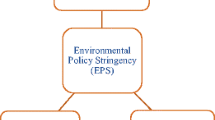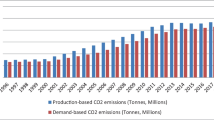Abstract
In 2019. the BICS (Brazil, India, China and South Africa) group remained not only one of the largest global CO2 emitter, but also most of the projected carbon emissions in the future and highly vulnerable to negative impacts of climate are associated with them. However, the recent literature finds number of studies having contradictory numbers about present and future carbon emissions in the BICS. It does not only affect the existing environmental regulations in the BICS but also mislead the future policy framework for the climate change. Thus, this study develops comprehensive forecasting model using Grey system theory approach for policy analysis. The variables (i.e. CO2 emissions, environmental related technological change, fossil fuel and renewable energy consumption, and economic output) are used to predict CO2 emissions. The results find that the emissions intensity will continue to rise in BICS region. However, the significant progress at environmental technology front can reduce the CO2 emissions intensity while achieving the economic growth targets. The results also find that the fossil fuels will remain the significant source of energy mix in BICS countries. The use of renewable energy is expected to increase during the projection period. The results are useful for BICS countries in shaping future environmental policy.





Similar content being viewed by others
References
Ahmed K, Ahmed S (2018) A predictive analysis of CO 2 emissions, environmental policy stringency, and economic growth in China. Environ Sci Pollut Res 25(16):16091–16100
Ahmed K, Long W (2013) Climate change and trade policy: from legal complications to time factor. J Int Trade Law Policy
Ahmed K, Bhattacharya M, Shaikh Z, Ramzan M, Ozturk I (2017) Emission intensive growth and trade in the era of the Association of Southeast Asian Nations (ASEAN) integration: An empirical investigation from ASEAN-8. J Clean Prod 154:530– 540
AlFarra HJ, Abu-Hijleh B (2012) The potential role of nuclear energy in mitigating CO2 emissions in the United Arab Emirates. Energy Policy 42:272–285
Ang JB (2007) CO2 Emissions, energy consumption, and output in France. Energy policy 35 (10):4772–4778
Apergis N, Payne JE, Menyah K, Wolde-Rufael Y (2010) On the causal dynamics between emissions, nuclear energy, renewable energy, and economic growth. Ecol Econ 69(11):2255– 2260
Cui J, Liu SF, Zeng B, Xie NM (2013) Parameters characteristics of grey Verhulst prediction model under multiple transformation. Control and decision 28(4):605–608
Cui J, Li B, Ma H, Yuan C, Liu S, Zhang H, Song X (2016) Properties of NGM (1, 1, v) and its optimized model with multiple transformation. J Grey Syst 28(4)
da Silva Soito JL, Freitas MAV (2011) Amazon and the expansion of hydropower in Brazil:, Vulnerability, impacts and possibilities for adaptation to global climate change. Renew Sust Energ Rev 15(6):3165–3177
Deng JL (1982) A new modelling approach to insect reproduction with same-shape reproduction distribution and rate summation: with particular reference to Russian wheat aphid. Syst Control Lett 5:288–294
Fadel M, Zohri ANA, Makawy M, Hsona MS, Abdel-Aziz AM (2014) Recycling of vinasse in ethanol fermentation and application in Egyptian distillery factories. Afr J Biotechnol 13(47)
Fei Q, Rasiah R, Shen LJ (2014) The clean energy-growth nexus with CO2 emissions and technological innovation in Norway and New Zealand. Energy Environ 25(8):1323–1344
Hatzigeorgiou E, Polatidis H, Haralambopoulos D (2011) CO2 Emissions, GDP and energy intensity: a multivariate cointegration and causality analysis for Greece, 1977–2007. Appl Energy 88(4):1377–1385
Hochstetler K, Viola E (2011) Brazil and the multiscalar politics of climate change. In: Colorado conference on earth systems governance, Colorado State University, Fort Collins, Colorado, pp 17–20
Hu Z, Zhang CH (2019) A national analysis of the geographic aspects and ecological correlates of PM 2.5 in China based on ground observational data. Air Qual Atmos Health 12(4):425– 434
IEA (2019). https://www.epa.gov/ghgemissions/global-greenhouse-gas-emissions-data [Accessed 25.02.2020]
IEA (2009). https://www.iea.org/data-and-statistics?country=WORLD&fuel=Energy%20supply&indicator=Coal%20production%20by%20type [Accessed 25.02.2020]
IPCC (2014). https://www.ipcc.ch/report/ar5/wg3/ [Accessed 25.02.2020]
Katani EK (2019) Forecasting the total energy consumption in Ghana using grey models. Grey systems: theory and application
Ma X, Liu Z, Wei Y, Kong X (2016) A novel kernel regularized nonlinear GMC (1, n) model and its application. J Grey Syst-UK 28(3):97
Meng D, Zhicun X, Wu L, Yang Y (2020) Predict the particulate matter concentrations in 128 cities of China. Air Qual Atmos Health :1-9
Menyah K, Wolde-Rufael Y (2010) Energy consumption, pollutant emissions and economic growth in South Africa. Energy Econ 32(6):1374–1382
Pao HT, Tsai CM (2010) CO2 Emissions, energy consumption and economic growth in BRIC countries. Energy Policy 38(12):7850–7860
Qi X, Han Y (2020) Andamp; Kou P Population urbanization, trade openness and carbon emissions: an empirical analysis based on China. Air Qual Atmos Health :1–10
Sadorsky P (2009) Renewable energy consumption and income in emerging economies. Energy Policy 37(10):4021–4028
Salahuddin M, Gow J (2014) Economic growth, energy consumption and CO2 emissions in Gulf Cooperation Council countries. Energy 73:44–58
Salim RA, Shafiei S (2014) Urbanization and renewable and non-renewable energy consumption in OECD countries: an empirical analysis. Econ Model 38:581–591
Sbia R, Shahbaz M, Hamdi H (2014) A contribution of foreign direct investment, clean energy, trade openness, carbon emissions and economic growth to energy demand in UAE. Econ Model 36:191–197
Sohag K, Begum RA, Abdullah SMS, Jaafar M (2015) Dynamics of energy use, technological innovation, economic growth and trade openness in Malaysia. Energy 90:1497–1507
Sohag K, Al Mamun M, Uddin GS, Ahmed AM (2017) Sectoral output, energy use, and CO 2 emission in middle-income countries. Environ Sci Pollut Res 24(10):9754–9764
Soytas U, Sari R, Ewing BT (2007) Energy consumption, income, and carbon emissions in the United States. Ecol Econ 62(3-4):482–489
Statista (2019) https://www.statista.com/statistics/264699/worldwide-CO_2-emissions/ [Accessed25.02.2020]
Tang R, Wang J (2013) A note on multiple reflections of radiation within CPCs and its effect on calculations of energy collection. Renew Energ 57:490–496
Tien TL (2012) A research on the grey prediction model GM (1, n). Appl Math Comput 218 (9):4903–4916
Vapnik VN (1998) Communications and control. Stat Learn Theory 2:1–740
Wang ZX, Wang YY (2014) Evaluation of the provincial competitiveness of the Chinese high-tech industry using an improved TOPSIS method. Expert Syst Appl 41(6):2824–2831
Wolf Jr C, Dalal S, DaVanzo J, Larson EV, Akhmedjonov A, Dogo H, Huang M, Montoya S (2011) China and India, 2025: A comparative assessment. RAND NATIONAL DEFENSE RESEARCH INST SANTA MONICA CA
Xie NM, Liu SF (2008) Research on the affine properties of discrete grey model. Control and decision 23(2):200
Xie NM, Liu SF (2009) Discrete grey forecasting model and its optimization. Appl Math Model 33(2):1173–1186
Zhou P, Poh KL, Ang BW (2016) Data envelopment analysis for measuring environmental performance. In: Handbook of operations analytics using data envelopment analysis. Springer, Boston, pp 31–49
Author information
Authors and Affiliations
Corresponding author
Additional information
Publisher’s note
Springer Nature remains neutral with regard to jurisdictional claims in published maps and institutional affiliations.
Electronic supplementary material
Below is the link to the electronic supplementary material.
Rights and permissions
About this article
Cite this article
Ahmed, S., Ahmed, K. & Ismail, M. Predictive analysis of CO2 emissions and the role of environmental technology, energy use and economic output: evidence from emerging economies. Air Qual Atmos Health 13, 1035–1044 (2020). https://doi.org/10.1007/s11869-020-00855-1
Received:
Accepted:
Published:
Issue Date:
DOI: https://doi.org/10.1007/s11869-020-00855-1




